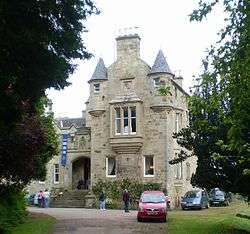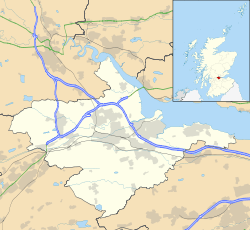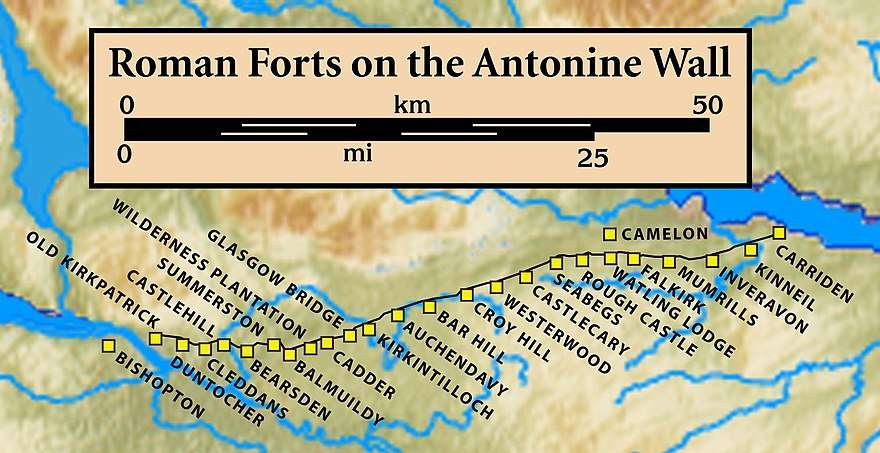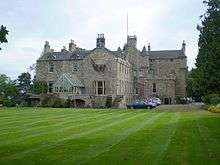Carriden House
Carriden House is a 14,041 square feet (1,304.5 m2) mansion in the parish of Bo'ness and Carriden, in the Falkirk council area, east central Scotland.[1] It is located on the Antonine Wall 2.5 kilometres (1.6 mi) east of Bo'ness, and 4 kilometres (2.5 mi) north-east of Linlithgow, in the former county of West Lothian.[2] The earliest part of the house is an early 17th-century tower house, which was extended in the 17th and 19th centuries.[3] Carriden House is protected as a category A listed building.[4]
| Carriden House | |
|---|---|
 South front of Carriden House | |
| Location | Bo'ness, Falkirk |
| Coordinates | 56°00′38″N 3°33′55″W |
| Built | 1602 |
| Built for | John Hamilton of Letterick |
Listed Building – Category A | |
| Designated | 25 November 1980 |
| Reference no. | LB22339 |
 Carriden House within Falkirk council area | |
Etymology of name
Carriden is etymologically a Cumbric name. The first element is agreed to be *kair 'fortification'. The second element is more doubtful, but seems fairly likely to be the same regional name Eidyn that also appears in Edinburgh.[5]
History

Carriden House is located west of the site of an Antonine Roman fort.[6] This formed the eastern end of the Antonine Wall.[7] It is the only Antonine Fort whose Latin name, Veluniate, is known.[8] A centurion's stone was reported as built into the house, according to Sir George Macdonald who wrote about it.[9] Finds from the fort include some window fragments.[10] One suggested interpretation is that Carriden formed a chain of Lothian forts along with Cramond and Inveresk.[11] A tower probably stood on this site in the 16th century, and this was rebuilt or replaced in 1602 by John Hamilton of Lettrick. The tower was purchased later in the 17th century by the Mylne family, a prominent dynasty of masons and architects, and a west wing was added by Alexander Mylne. During the 18th century the house had many owners, and landscaping works were carried out in the grounds.[4]
In 1814, the house was bought by Admiral Sir George Johnstone Hope (1767–1818), a veteran naval officer. His son Sir James Hope (1808–1881) made further alterations to the building, and also established the estate village of Muirhouses. The estate changed hands several more times, and by the 1970s was owned by the South of Scotland Electricity Board. Demolition was contemplated, to allow the building of a new power station on the site. This proposal was rejected and the house fell into disrepair. It the latter part of the 20th century the house was purchased from the SSEB by the Barkhouse family and restored as a private residence. The house has since undergone further renovation and modernisation, and continues to be a private family residence.

Description
The house is on an L-plan, and comprises the original tower house and the 17th-century wing. The tower house, dated 1602, is of three storeys and was remodelled in the 19th century. The two-storey wing added by Alexander Mylne is to the west, and bears a 1682 date stone. The study on the first floor has a 17th-century plaster ceiling described as "particularly exceptional".[4] The porch in the angle of the L is also a 19th-century addition.
References
- "Country House (19th Century), Hospital (First World War), Tower House (16th Century)". CANMORE. Royal Commission on the Ancient and Historical Monuments of Scotland. Retrieved 14 November 2017.
- "OS 25 inch 1892-1949". National Library of Scotland. Ordnance Survey. Retrieved 26 October 2017.
- Salmon, Thomas James (1913). Borrowstounness and district, being historical sketches of Kinneil, Carriden, and Bo'ness, c. 1550-1850. Edinburgh: William Hodge and Co. pp. 163–199. Retrieved 9 December 2017.
- Historic Environment Scotland. "Carriden, Carriden House Including Boundary Walls (Category A) (LB22339)". Retrieved 27 March 2019.
- Bethany Fox, 'The P-Celtic Place-Names of North-East England and South-East Scotland', The Heroic Age, 10 (2007), http://www.heroicage.org/issues/10/fox.html (appendix at http://www.heroicage.org/issues/10/fox-appendix.html).
- "Fort Annexe (Roman), Roman Fort (Roman), Settlement (Roman)". CANMORE. Royal Commission on the Ancient and Historical Monuments of Scotland. Retrieved 14 November 2017.
- Krakowka, Kathryn. "Meticulous metric survey of the Antonine Wall". Current Archaeology. Retrieved 28 April 2018.
- Rohl, Darrell, Jesse. "More than a Roman Monument: A Place-centred Approach to the Long-term History and Archaeology of the Antonine Wall" (PDF). Durham Theses. Durham University. Available at Durham E-Theses Online ref: 9458. Retrieved 14 October 2017.
- Macdonald, Sir George (1934). The Roman wall in Scotland, by Sir George Macdonald (2d ed., rev., enl., and in great part rewritten ed.). Oxford: The Clarendon press. pp. 190–191. Retrieved 11 October 2017.
- "Stone window fragments, Carriden". Retrieved 9 December 2017.
- "Velvniate Roman Fort & Marching Camps Minor Romano-British Settlement Borrowstounness, Carriden, Central". Roman Britain. Archived from the original on 20 October 2018. Retrieved 9 December 2017.